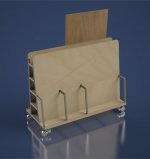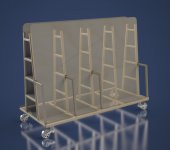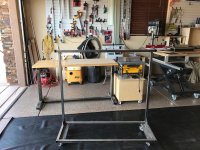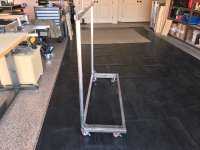ryanjg117
Member
- Joined
- May 18, 2015
- Messages
- 333
The shop is a mess, mostly due to insufficient storage space for plywood sheets and off-cuts, so I've finished up a design for a new gargantuan rolling material cart. Based on the familiar A-frame style, I scaled it up quite a bit and am looking to build the chassis from 1-1/2 x 1-1/2 x 3/32" square steel tube. This will be my first project to learn stick welding, so I figured, what better starter project than something weighing around 500 lbs empty and capable of easily killing myself if only a few welds failed?
The cart is large enough to hold two stacks of 4x8 plywood sheets on end.
I'm not sure if the steel tubing is thick enough for this application, so if anyone has any metal-fab experience I would love to hear your opinion.
I was going to select sheet metal for the shelves but it appears 16 ga 4x8 sheet metal is phenomenally expensive (it would have been around $600 alone for the sheet metal on this project). So instead, I'll be using some of my plywood remnants. Knocking out two birds with one stone: using up some of the scraps while I build storage for more scraps.
Here's the design as it stands today:





The cart is large enough to hold two stacks of 4x8 plywood sheets on end.
I'm not sure if the steel tubing is thick enough for this application, so if anyone has any metal-fab experience I would love to hear your opinion.
I was going to select sheet metal for the shelves but it appears 16 ga 4x8 sheet metal is phenomenally expensive (it would have been around $600 alone for the sheet metal on this project). So instead, I'll be using some of my plywood remnants. Knocking out two birds with one stone: using up some of the scraps while I build storage for more scraps.
Here's the design as it stands today:







